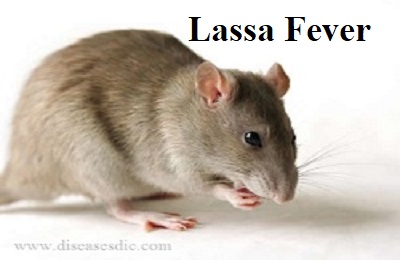Definition
Lassa fever is an acute viral hemorrhagic illness caused by the lassa virus, a member of the arenavirus family of viruses. It is transmitted to humans from contacts with food or household items contaminated with rodent excreta. The disease is endemic in the rodent population in parts of west Africa. Person to person infection and laboratory transmission can also occur, particularly in the hospital environment in the absence of adequate infection control measures. Diagnosis and prompt treatment are essential.
History
Lassa fever was first described in the 1950s, and the viral particle was identified in 1969 from three missionary nurses who died in Lassa, Nigeria, after caring for an infected obstetrical patient. Lassa fever is one of the hemorrhagic fever viruses, occurring in West Africa in similar areas as Ebola virus. There are 100,000-300,000 cases of Lassa fever each year in the world, causing an estimated 5,000 deaths and about 10%-15% of admissions to hospitals in Sierra Leone and Liberia. Deaths are especially common in children. Case fatality is 1% in general, although severe cases have a case fatality of 15%.
Lassa fever has rarely been diagnosed in the U.S. each year, largely as a result of international travel or immigration. A case was diagnosed in May 2015 in New Jersey in a patient traveling from Liberia, the sixth active case documented in returning travelers to the U.S. since 1969.
Epidemiology
Around 300,000 people are infected annually, with up to 5,000 deaths per year. It is relatively common in parts of West Africa where the multimammate rat is common, particularly Guinea (Kindia, Faranah and Nzerekore regions), Liberia (mostly in Lofa, Bong, and Nimba counties), Nigeria (everywhere) and Sierra Leone (typically from Kenema and Kailahun districts). It is present but less common in the Central African Republic, Mali, Senegal and other nearby countries, and less common yet in Ghana and the Democratic Republic of the Congo. Benin had its first confirmed cases in 2014, and Togo had its first confirmed cases in 2016.
Causes of lassa fever
The main cause of Lassa virus is a rodent known as the Multimammate Rat of the genus Mastomys but it is not sure that which species of Mastomys are associated with Lassa fever.
- Mastomys rodents breed very frequently, produce large numbers of children, and are frequent in the savannas and forests of West, Central, and East Africa.
- Mastomys generally readily colonize human homes.
- There are a number of ways in which the virus may be transmitted, or spread, to humans.
- The Mastomys rodents drop the virus in urine and compost. The virus can be transmitted through direct contact with these materials.
- Through touching objects or eating contaminated food
- Through cuts or sores, the virus transmitted in the human body
- It may also spread through person-to-person contact when a person comes into contact with virus in the blood, tissue, secretions, or excretions of an individual infected with the Lassa virus.
- Contact with the virus occurs when a person inhales tiny particles in the air contaminated with rodent excretions
- All these factors together contribute to the relatively efficient spread of Lassa virus from infected rodents to humans.
Symptoms of lassa fever
Signs and symptoms of Lassa fever typically occur 1-3 weeks after the patient comes into contact with the virus. These include
- Abdominal Pain
- Back Pain
- Chest Pain
- Conjunctivitis
- Cough
- Diarrhea
- Facial Swelling
- Fever
- Mucosal Bleeding
- Proteinuria
- Sore Throat
- Vomiting
In severe cases,
- Encephalopathy
- Haemorrhage
- Hypotension
- Pleural Effusion
- Seizures
- Swelling of Face and Neck
Approximately 15% of hospitalized patients die. The disease is more severe in pregnancy, and fetal loss occurs in greater than 80% of cases.
Diagnosis and test
There are various laboratory tests that are performed to diagnose the disease and assess its course and complications.
- Lassa fever is most often diagnosed by using Enzyme-Linked Immunosorbent Serologic Assays or ELISA, which detect IgM and IgG antibodies as well as Lassa antigen.
- The virus can also be detected by Reverse Transcription-Polymerase Chain Reaction (RT-PCR).
Other laboratory findings in Lassa fever include
- Elevated Aspartate Aminotransferase (AST) levels in the blood
- Lymphopenia (low white blood cell count)
- Thrombocytopenia: low Hb due to bleeding from GI tract
- Coagulation studies and LFTs may also be abnormal.
Treatment and medications
Ribavirin, is an antiviral drug that has been used with success in people affected by Lassa fever. It has been shown to be most effective when it is administered early in the course of the illness. People should also receive supportive care that consists of maintenance of:
- Oxygenation
- Blood pressure
- Treatment of complicating infections
- Appropriate fluid and electrolyte balance
Antiviral drug ribavirin
Prevention of lassa fever
- Isolating infected patients from contact with unprotected persons until the disease has run its course.
- Putting food away in rodent-proof containers and keeping the home clean help to discourage rodents from entering homes.
- Transmission of the Lassa virus from rodent to humans can be prevented by avoiding contact with Mastomys rodents
- Trapping in and around homes can help reduce rodent populations.
- Using infection control measures, such as complete equipment sterilization;
- Wearing protective clothing, such as Masks, gloves, gowns, and goggles
- When caring for patients with Lassa fever, further transmission of the disease through person-to-person contact can be avoided by taking preventive precautions against contact with patient secretions.

